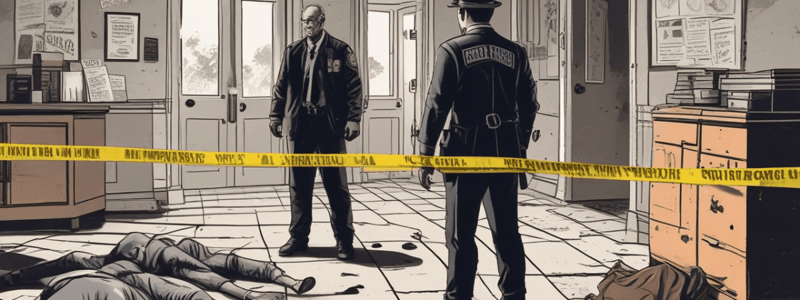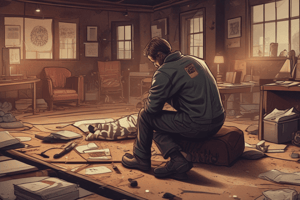Podcast
Questions and Answers
What is the primary purpose of the first contact in an assault investigation?
What is the primary purpose of the first contact in an assault investigation?
- To obtain witness statements
- To establish the suspect's motive
- To file an offense report
- To establish the elements of the offense (correct)
Why should investigators consider the possibility of a more serious crime?
Why should investigators consider the possibility of a more serious crime?
- To intimidate the suspect
- Because assaults can be part of a larger crime (correct)
- To justify excessive force
- To determine the severity of the attack
What should be included in the complete investigation of an assault?
What should be included in the complete investigation of an assault?
- All elements of the offense, motive, intent, opportunity, and prior history (correct)
- Only the elements of the offense
- Only the victim's statement
- Statements from witnesses and suspects
Why should an offense report be made, even if the victim does not wish to pursue prosecution?
Why should an offense report be made, even if the victim does not wish to pursue prosecution?
What type of disturbances are assault crimes often part of?
What type of disturbances are assault crimes often part of?
What proportion of assailants are typically known to the victims in assault cases?
What proportion of assailants are typically known to the victims in assault cases?
What is often a consequence of a victim changing their mind about prosecution in an assault case?
What is often a consequence of a victim changing their mind about prosecution in an assault case?
What type of photos are used to document injuries in an assault investigation?
What type of photos are used to document injuries in an assault investigation?
What is a primary objective of a criminal investigation in an assault case?
What is a primary objective of a criminal investigation in an assault case?
What is a common characteristic of assault cases?
What is a common characteristic of assault cases?
Why might law enforcement use discretion in an assault case?
Why might law enforcement use discretion in an assault case?
What is a key aspect of investigating an assault case?
What is a key aspect of investigating an assault case?
What should be done if the victim is seriously injured?
What should be done if the victim is seriously injured?
What is a common type of call that an officer may experience?
What is a common type of call that an officer may experience?
What should an officer do if injuries are not serious?
What should an officer do if injuries are not serious?
What is an important aspect of evaluating a peace disturbance?
What is an important aspect of evaluating a peace disturbance?
What type of evidence can be found at an assault scene?
What type of evidence can be found at an assault scene?
What should an officer do when approaching a fight in progress?
What should an officer do when approaching a fight in progress?
What is a key step in responding to an assault call?
What is a key step in responding to an assault call?
What should an officer do if a victim is unconscious?
What should an officer do if a victim is unconscious?
What is a key aspect of investigating a suspected weapon?
What is a key aspect of investigating a suspected weapon?
Flashcards are hidden until you start studying
Study Notes
Introduction to Assault Investigation
- The primary objectives of a criminal investigation include identifying focal areas, documenting injuries, and collecting evidence.
- A procedure for conducting an assault investigation involves identifying the relationship between assaults and peace disturbances, and the main objectives and steps in a preliminary investigation.
General Facts Pertaining to Assaults
- Assaults can range from a punch or shove to a shooting or stabbing.
- Two-thirds of assailants are known to the victims, often being a spouse, relative, or acquaintance.
- Victims often change their mind about prosecution, usually after a few days, and may "kiss and make up" with the suspect.
Focus of Assault Investigation
- Obtaining evidence of injuries involved:
- Photographing injuries (overall and close-up photos)
- Obtaining statements from doctors and medical examination results
- Documenting injury details (location, shape, size, direction)
- Recovering the weapon:
- Determining if the weapon could have caused the injuries
- Examining the weapon for trace evidence
- Photographing the weapon
- Victim's statement:
- Obtaining a statement quickly if the victim is seriously injured
- Recording any statements or dying declarations
- Witnesses' statements:
- Determining if witnesses know the victim or suspect
- Evaluating the validity and reliability of witnesses
- Assessing bias or impartiality
Conducting an Assault Investigation
- Refer to the attached handout for procedures
- Evaluating the circumstances of a peace disturbance:
- Family disturbances
- Loud parties
- Standby to keep the peace
- Dispersing a large party or ensuring one party leaves in a family disturbance
Physical Evidence Found at Assault Scenes
- At the scene:
- Fingerprints (latent and patent in blood)
- Blood
- Cigarette butts
- Clothing fibers
- Weapons
- Spent bullets/empty casings
- Gunshot residue
- Shoeprints
- Victim's body
- Bindings
- Overturned furniture/broken items (signs of a struggle)
- At the hospital:
- Bullets extracted during surgery
- Victim's clothing (bloody, torn, or with trace evidence)
Sample Policy & Procedure
- Investigating all reported assaults, even if the victim does not desire prosecution
- Responding to the call:
- Rendering treatment to the injured party
- Assisting the injured, even if it means the suspects escape
- Pursuing the suspect if injuries are not serious
- Using caution when moving through a crowd
- Calming the participants, obtaining facts, and deciding on a course of action
- Determining who started the fight, who was involved, extent of involvement, witnesses, and injuries
Studying That Suits You
Use AI to generate personalized quizzes and flashcards to suit your learning preferences.




